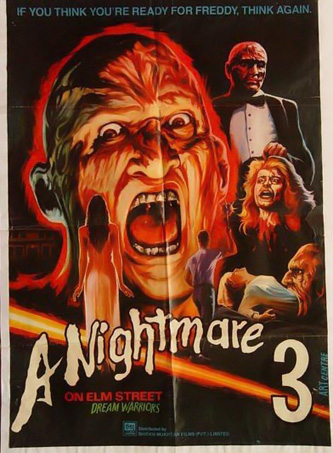
A NIGHTMARE ON ELM STREET 3: DREAM WARRIORS
US, 1987, 96 minutes. Colour.
Heather Langenkamp, Craig Wasson, Patricia Arquette, Robert Englund, Jennifer Rubin, Laurence Fishburne, John Saxon, Priscilla Pointer, Brooke Bundy, with cameos by Dick Cavett and Zsa Zsa Gabor.
Directed by Chuck Russell.
A Nightmare on Elm Street 3 was welcomed when it was first released. It takes up the story immediately from the first episode and is written by the original writer and director, Wes Craven. It was directed by Chuck Russell, his first film as director, later making a variety of genre films like Eraser, Bless the Child, Scorpion King.
Heather Langenkamp is Nancy and has grown up after her nightmares as a teenager. She is now a therapist. She encounters youngsters in an institution who are experiencing the same nightmares with Freddy Krueger. The principal teenager is played by Patricia Arquette in her first major role. Nancy has the ability to enter into the dreams and wants to confront Freddy Krueger who is murdering the teenagers one by one.
Laurence Fishburne and Craig Wasson are doctors, John Saxon also appears – and, of all things, a cameo by Zsa Zsa Gabor as well as television personality Dick Cavett.
There were to be another four sequels as well as a reunion of some of the characters to reflect on what the films had meant (and experience more nightmares). The original film was remade in 2010.
1. Audiences and their enjoyment of horror? The effect of horror? Shock, fear? Dreams and nightmares? Scientific approach? As portrayed in this series?
2. The film as a sequel, taking up the episodes from the first film? The character of Freddy Krueger developed in the second?
3. The atmosphere, ordinary homes, the mental institution, hospital atmosphere? The plausibility of the characters and plot? The musical score?
4. The visualising of the dreams, the dreamscapes? The special effects? Imagination and fear? The house itself? Freddy Krueger and his appearance, his face, his knives? The children, the infernos? The car yard, the skeletons?
5. Dreams and nightmares, the youngsters not wanting to keep, for fear that they would be killed in their dreams? Freddy Krueger in their dreams?
6. The plot, Nancy going to the hospital, Kristen and her experience, the hospital, the treatment, the other teenagers? The issue of vengeance? The foundation for it? The fight? The nun?
7. Freddy Krueger, his ugliness, his background, child molester, murderer? A monster? Appearance, deceitful, cruel? Appearing in dreams? The nun and the warning? The interference? His never being at rest?
8. Nancy and her original experience, the rhyme, with the group? Neil, his work in the hospital? The drugs? Pleading? Her entering into the dreams with Kirsten, hypnosis? The attempt to expel Freddy? The issue of the father? The return, heroes? The father’s visit? Death – for others?
9. Kirsten and her mother, Philip and his death, the girl in the television, the magic, the drugged girl, the African American, Johnny and the sexuality? The arbitrary deaths?
10. The hospital and treatment, Doctor Simms and and her harsh approach, the experience of guilt?
11. Neil and his success? Nancy, the drugs, her father, the burial? The end? The nun?
12. The role of horror films, their purpose, their effect? The continued popularity of this series throughout the decades?